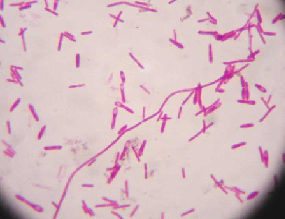|
Bacillus |
|
Spirillum |
|
Staphylococcus |
|
Streptococcus |
|
Clostridium Tetani |
|
Amphitrichous Flagella |
|
Peritrichous Flagella |
 Mycobacterium Tuberculosis |
|
Capsule Stain |
|
Ubiquity of Microbes - Microorganisms
They are everywhere. They are free-living and do not need a host.
They are commensal/mutualistic - they benefit/we benefit.
They can also be opportunistic pathogens - if conditions are right they multiply and cause harm. |
|
Colony - each dot
Only takes one cell on nutrient medium to start growing/multiplying.
Eventually you can see an area of growth on the medium = colony.
Morphology - study of shape |
|
Stains are solutions consisting of a solvent and a dye.
Charged regions of the dye molecule that give color are termed chromophores.
Chromophores stain bacteria through bonds formed with the cell. Bacterial cell surfaces tend to have a - charge so a dye with a + chromophore will adhere to the cell.
|
|
Differential Stain - allows us to detect changes between organisms
2 stain process with de-colorization inbetween. Iodine added as mordant. Decolor (alcohol wash). Gram - will decolor. Gram + - keep color. |
|
Poor technique and age can give false results.
Shapes of bacteria:
Bacillus - rod shaped Coccus - spherical shaped Spirillum - spiral shaped Staphylo - cluster arrangement Strepto - chain arrangement |
|
Primary stain in ZN method is Carbolfuschin (red).
Alcohol is used as a decolorizer in non-acid fast cells. Acid fast cells will not decolorize. After decolorizing, another stain is applied to those that lost the carbolfuschin stain. Methylene blue is used.
Acid fast=red. Non-acid fast=blue. |
|
Endospore - a dormant form of bacterium. Not all bacteria form endospores.
If a bacteria produces an endospore it means the conditions around it have deteriorated.
Spores resist heat as well as most chemicals.
Tough outer coating of a spore is made of keratin. |
|
Hanging Drop - wet mount that is inverted on a depression slide.
Ring of petroleum jelly prevents evaporation of H2O and allows coverslip to adhere to depression slide.
Motility should not be confused with Brownian Motion. |
|
Gram Stain after Heat Fix
1-Cover smear with crystal violet stain for 1 minute. 2-Rinse with distilled H2O. 3-Cover Smear with iodine for 1 minute. 4-Rinse with distilled H2O. 5-Decolorize with alcohol until run-off is clear. 6-Rinse with distilled H2O. 7-Counterstain with safranin for 1 minute. 8-Rinse with distilled H2O. |







